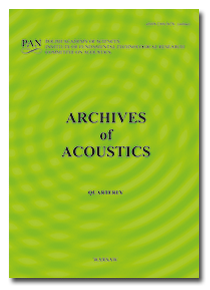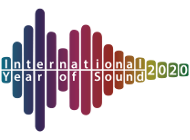10.24425/aoa.2018.125155
Significance of Binaural Synthesis on the Spatial Acoustic Impression of Enclosures
References
Alonso A., Suárez R., Sendra J.J. (2017), Virtual reconstruction of indoor acoustics in cathedrals: the case of the Cathedral of Granada, Building Simulation, 10, 4, 431–446.
Barron M. (2000), Measured early lateral energy fractions in concert halls and opera houses, Journal of Sound and Vibrations, 232, 1, 79–100.
Barron M., Marshall A. (1981), Spatial impression due to early lateral reflections in concert halls: the derivation of a physical measure, Journal of Sound and Vibrations, 77, 2, 211–232.
Becker J., Sapp M. (2001), Synthetic soundfields for the rating of spatial perceptions, Applied Acoustics, 62, 2, 217–228.
Blauert J., Lindemann W. (1986), Auditory spaciousness: some further psychoacoustic analyses, The Journal of the Acoustical Society of America, 80, 2, 533–542.
Bork I. (2005), Report on the 3rd round robin on room acoustical computer simulation. Part II: Calculations, Acta Acustica united with Acustica, 91, 4, 753–763.
Bradley J., Soulodre G. (1995a), Objective measures of listener envelopment, The Journal of the Acoustical Society of America, 98, 5, 2590–2607.
Bradley J., Soulodre G. (1995b), The influence of late arriving energy on spatial impression, The Journal of the Acoustical Society of America, 97, 4, 2262–2271.
Cerdá S. et al. (2013), On the relations between audio features and room acoustic parameters of auralizations, Journal of Vibration and Acoustics, 135, 6, e-064501, 1–6, doi: 10.1115/1.4023835.
Cox T., D’Antonio P. (2004), Acoustic absorbers and diffusers, Spon Press, UK.
Dalenbäck B.I. (2011), CATT-Acoustic v9 powered by TUCT. User’s manual, Gothenburg.
Fischetti A., Jouhaneau J., Hemim Y. (1992), Relations between subjective spatialisation, geometrical parameters and acoustical criteria in concert halls, Applied Acoustics, 37, 3, 233–247.
Foteinou A., Murphy D., Masinton A. (2010), Investigation of factors influencing acoustic characteristics in geometric acoustics based auralization, [in:] 13th Int. Conference on Digital Audio Effects, Graz, September 1–4, 2010.
Griesinger D. (1997), The psychoacoustics of ASW, spaciousness and LEV, Acta Acustica united with Acustica, 83, 4, 721–731.
Hacihabiboglu H., Murtagh F. (2008), Perceptual simplification for model-based binaural room auralisation, Applied Acoustics, 69, 715–727.
International Organization for Standardization (2010), ISO 3382 Part 1. Acoustics – measurement of room acoustic parameters, performance spaces.
Kim S. (2013), Influence of height-channel contents on enhancing spatial impressions through virtually elevated loudspeaker, Proceedings of Meeting on Acoustics ICA2013, 19, 1, 055053, doi: 10.1121/1.4800821.
Kuttruff H. (2000), Room acoustics, 4th ed., Spon Press, London.
Lehnert H., Blauert J. (1992), Principles of binaural room simulation, Applied Acoustics, 36, 3–4, 259–291.
Martellotta F. (2008), Subjective study of preferred listening conditions in Italian Catholic churches, Journal of Sound and Vibrations, 317, 378–399.
Martellotta F. (2010), The just noticeable difference of center time and clarity index in large reverberant spaces, The Journal of the Acoustical Society of America, 128, 2, 654–663.
Masiero B., Fels J. (2011), Perceptually robust headphone equalization for binaural reproduction, Proceedings of 13th Convention Audio Engineering Society, May 13–16, London, UK.
Moller H. (1992), Fundamentals of binaural technology, Applied Acoustics, 36, 171–218.
Moller H., Sorensen M., Jensen F., Hammershoi D. (1996), Binaural technique: do we need individual recordings?, Journal of Audio Engineering Society, 44, 6, 451–469.
Murillo D. (2016), Interactive auralization based on hybrid simulation methods and plane wave expansion, Ph.D. Dissertation, Southampton University.
Murillo D., Cooper C., Fazi F. (2014), Acoustic survey of a late medieval building based on geometrical acoustics methods, [in:] Forum Acusticum 2014, Kraków, pp. 43–55.
Nowak J. (2010), On the influence of sampling error son the perception of spatial sound fields using spherical microphone arrays for auralization, The Journal of the Acoustical Society of America, 131, 4, 3208–3218.
Okano T., Beranek L., Hidaka T. (1998), Relations among interaural cross-correlation coefficient (IACCE), lateral fraction (LFE), and apparent source width (ASW) in concert halls, The Journal of the Acoustical Society of America, 104, 1, 255–265.
Physikalisch-Technische Bundesanstalt (PTB) database (n.d.), Braunschweig, Germany.
Rindel M., Christensen C. (2004), Predicting the acoustics of ancient open-air theatres: the importance of calculation methods and geometrical details, [in:] Baltic-Nordic Acoustics Meeting, Mariehamn, June 1–8, 2004.
Rowan D., Papadopoulos T., Edwards D., Allen R. (2015), Use of binaural and monaural cues to identify the lateral position of a virtual object using echoes, Hearing Research, 323, 32–39.
Rutherford A. (2001), Introducing ANOVA and ANCOVA: A GLM Approach, SAGE Publications: London.
Siltanen S., Lokki T., Savioja L., Christensen C. (2008), Geometry reduction in room acoustics modeling, Acta Acustica united with Acustica, 94, 3, 410–418.
Soulodre G., Lavoie M., Norcross S. (2003), Temporal aspects of listener envelopment in multichannel surround systems, Proceedings of 114th AES Convention, paper 580, March 22–25, The Netherlands, Amsterdam.
Van Dorp J., De Vries D., Lindau A. (2013), Deriving content-specific measures of room acoustic perception using a binaural, nonlinear auditory model, The Journal of the Acoustical Society of America, 133, 3, 1572–1585.
Vigeant M., Wang L., Rindel J. (2011), Objective and subjective evaluations of the multi-channel auralization technique as applied to solo instruments, Applied Acoustics, 72, 311–323.
Vorländer M. (2008), Auralization, 1st ed. Springer, Berlin.
Westphal S., Schoeffler M., Herre J. (2015), A Framework for Reporting Spatial Attributes of Sound Sources, ICMI Workshop.
DOI: 10.24425/aoa.2018.125155





